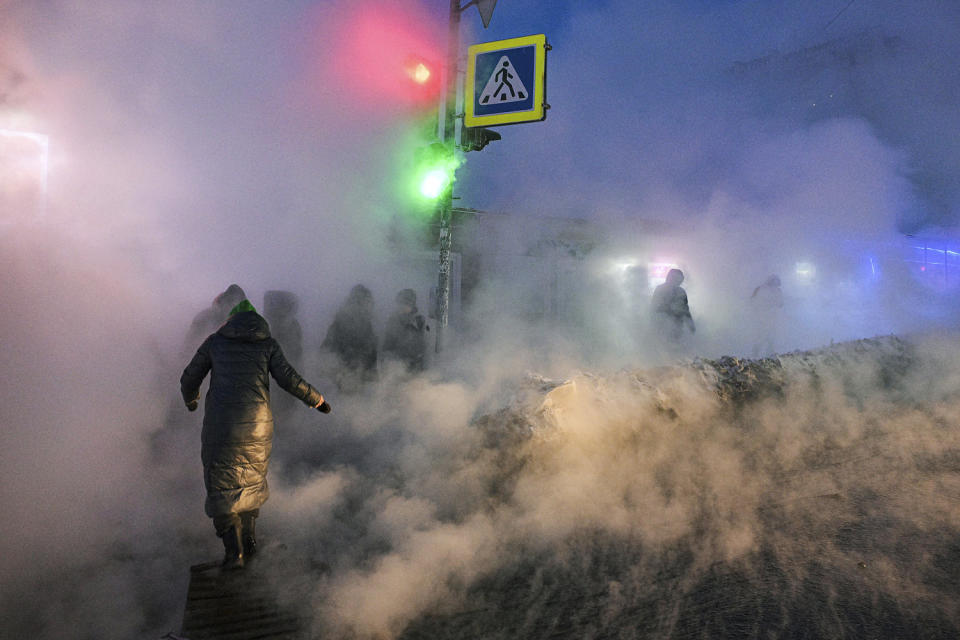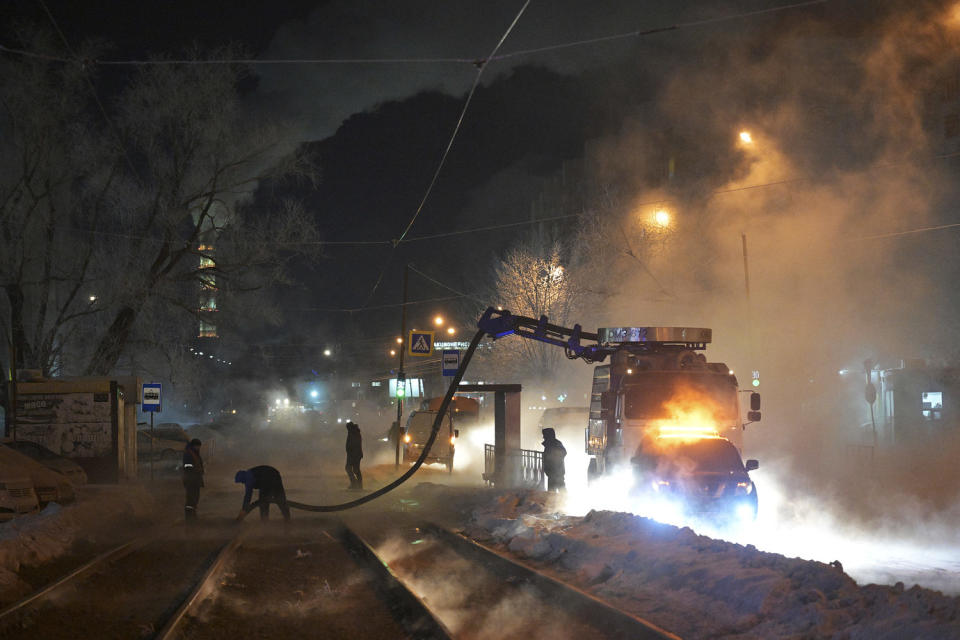Russians freeze as Putin’s war and aging pipes reveal cracks at home
- Oops!Something went wrong.Please try again later.
Two electric radiators were not enough to keep Russian pensioner Elena Grezkaya-Silko from shivering in her one-bedroom apartment.
After two major utility network accidents last month, she struggled to stay warm at home in the Siberian city of Novosibirsk, where temperatures regularly dip below minus 4 degrees Fahrenheit in January.
After the first accident Jan. 11, due to what authorities said was a defect in the main heating network, the heating batteries inside her apartment went cold, with only lukewarm and intermittent heating in her bathroom and kitchen. Then, a hot water pipe burst on the street near her building Jan. 17, sending a geyser of hot water and steam into the air.
Her bedroom remained “icy cold” after that, she told NBC News in a phone interview last month.
It forced Grezkaya-Silko, 51, to seek warmth in the nearby shopping center during the day and stick close to her home’s heaters in the evening, wrapping both herself and her cat in blankets. “I go there for the whole day — I warm up there, I eat there,” she said of the shopping center. “I come back home, turn the heaters on, we warm up with the cat and then we go to bed.”
The heating had finally come back, she said days later, after frequent calls to local authorities.
But her freezing frustrations are far from unique: Across Russia, creaking infrastructure and a wave of accidents have plunged households into the cold in the depth of winter, fueling rare showings of anger and irritation in a country where public criticism has been increasingly quashed.

Throughout late December and early January, Russian media was awash with coverage of accidents involving the country’s sprawling utility networks, which consist of heating and hot water mains.
It offered a jolt to the Kremlin ahead of the March presidential election, in which President Vladimir Putin is expected to easily secure another term despite the mounting costs of his war in Ukraine. While the Russian military has sought to target the energy infrastructure of its neighbor to turn up the pressure in the war, the Kremlin has had to contend with energy problems of its own at home.
The crisis has renewed a focus on the Soviet-era infrastructure still in use across Russia, which has not been uniformly modernized. And with the economy now firmly directed on the war in Ukraine, funding for such repairs is only scheduled to fall over the next couple of years.
“A considerable part of these networks was built during the Soviet era — the ‘70s and ‘80s,” Russian economist Igor Lipsits told NBC News. “So they are extremely worn out.”
When an accident in a centralized heating system causes heat and hot water to be cut off in extreme cold, the pipes in people’s homes freeze, leading to damage and cracks. When the heat comes back on, apartments and homes can become flooded, with boiling water often spewing out of radiators.
“It’s a pretty clumsy system,” Lipsits said. “There is an understanding that you have to move away from it toward boilers in people’s buildings and apartments. But it’s money, it’s investment, it’s work — so nobody is doing it. They are saving the old system. But it’s worn-out, it’s bursting.”

Numerous videos shared online in late December and January showed boiling hot water and rolls of steam escaping burst pipes inside people’s homes and apartment buildings. People also shared photos of low thermometer readings inside their homes and even frost build-up on their windows amid heating outages caused by the accidents. Several videos also showed burst mains outside in freezing temperatures, with water sprouting onto the streets, forming thick steam clouds.
Residents of the Moscow region town of Khimki, where there was a main pipeline accident in early January, held up “SOS” banners as they complained about a lack of heat in bitter cold, asking Putin and the regional governor to intervene in a video. “We are freezing,” a woman says in the video.
And in the Moscow region town of Podolsk, 170 apartment buildings were left without heat in minus 6 degree weather in early January after a break in the heating main, Tass reported. Putin reportedly did get involved in this case, ordering the nationalization of the utility plant whose boilers caused havoc there, according to the region’s governor, Andrei Vorobyev.
Several incidents, including the ones in Podolsk and one in Nizhny Novgorod that led to 12 people being burned from a burst pipe, saw criminal proceedings opened.
A bitterly cold December and January is not a novelty in most of Russia, although the Kremlin still tried to blame the crisis on what spokesman Dmitry Peskov called “abnormal frosts” when asked about it last month.
But Peskov admitted that “despite all the titanic efforts to update all housing and communal services systems, a certain part of them remains in a rather dilapidated state,” and it was impossible to update everything in 10 or even 15 years.
According to Russia’s Construction and Communal Services Ministry, there are plans to invest at least 4.5 trillion rubles (more than $49 billion) in modernizing utility infrastructure up to 2030, but the reality on the ground means the number of accidents continues to grow. During a 2022 meeting, it was reported that 31% of heating supply networks, more than 45% of sewage networks and over 43% of water supply networks across Russia needed to be replaced, according to the Kremlin.
At the peak of the crisis, Putin himself said that it was important not to neglect problems with the communal services and to be proactive.
Still, the Kremlin would have preferred to avoid any hints of internal dissent less than two months before the election, especially when it could raise questions about government spending priorities amid the colossal costs of Putin’s war in Ukraine.
“Cities are freezing. Who is to blame?” Boris Nadezhdin, who emerged as a prominent anti-war figure but was barred Thursday from running in the presidential election, said of the crisis last month. “The huge amount of money spent and reserved for the special military operation could have been invested in improving the quality of life of my fellow citizens,” he said in a post on the Telegram messaging app.
Putin’s economy has largely weathered Western sanctions imposed because of the war, but it’s now more military-oriented than ever. More than 10.7 trillion rubles ($118 billion) was allocated to “national defense” this year, according to a report by the Russian finance ministry.
The same report shows that funding for housing and communal services was 881 billion rubles ($9.7 billion) this year, up from 593 billion ($6.5 billion) in 2021, but the budgeted allocation is supposed to go down to 381 billion ($4.2 billion) in 2026.
Lipsits said the reality is that fixing the existing utility networks would take tens of billions of dollars, money that is not there because it’s going to the war in Ukraine.
“It’s a slightly apocalyptic picture, but it reflects that Russia is a complicated country,” Lipsits said of the Soviet-era infrastructure. “A lot of money needed to be invested in it for peaceful purposes — to fix it up and make it suitable for life in the 21st century,” he added. “But instead of this, the money went to the war.”
This article was originally published on NBCNews.com

